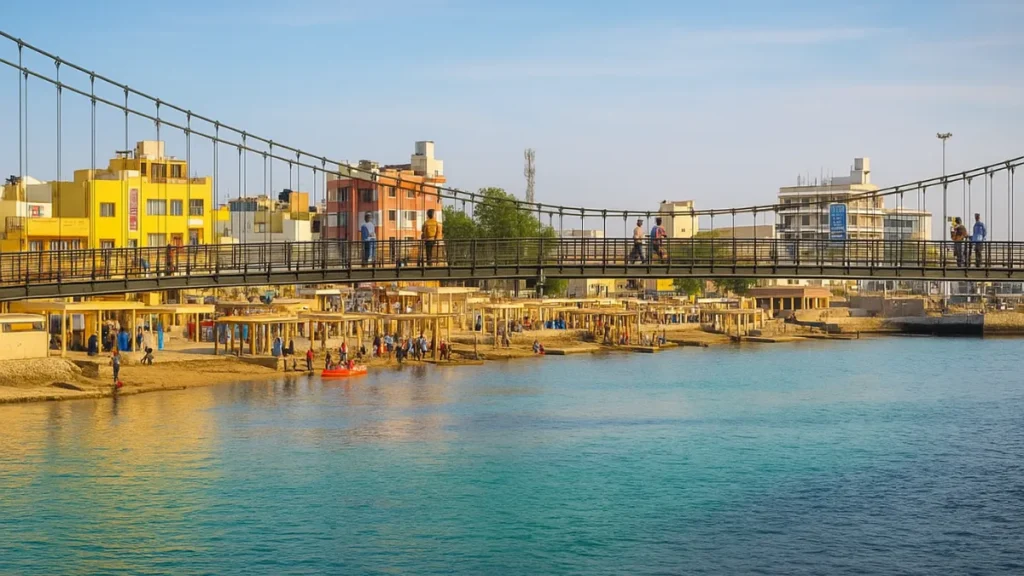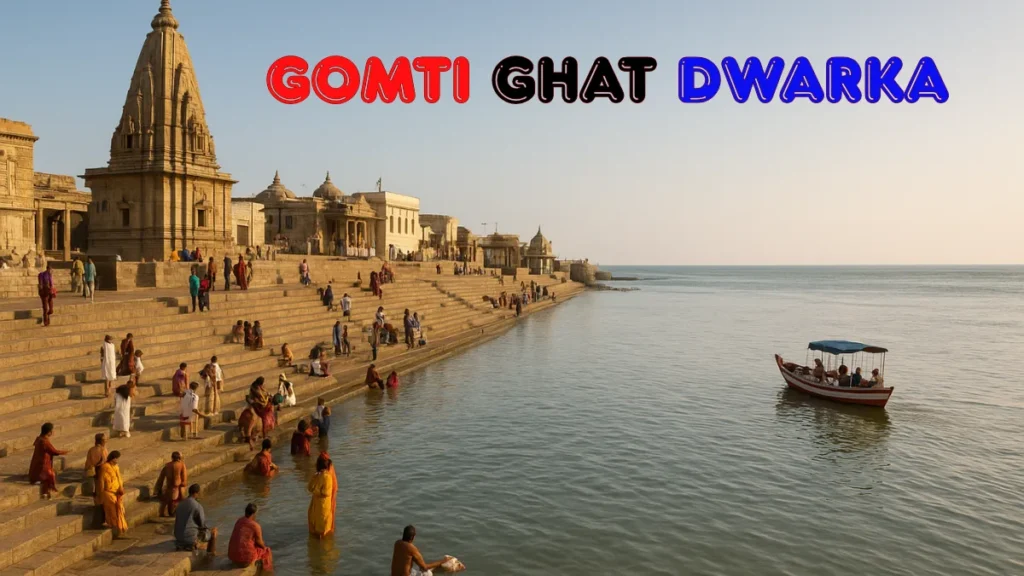Gomti Ghat Dwarka is one of the most revered pilgrimage sites in Gujarat, India. Located in the holy city of Dwarka, the land associated with Lord Krishna, this ghat holds immense spiritual significance. The sacred Gomti River flows quietly towards the Arabian Sea here, and pilgrims believe that taking a holy dip in its waters washes away sins and brings divine blessings.
The Religious Significance of Gomti Ghat Dwarka
Hindu scriptures describe the Gomti River as the daughter of Sage Vashishta and the sister of Lord Krishna. That is why the river is regarded with deep respect, and its banks are considered sacred. Pilgrims visiting Dwarka often begin their journey at Gomti Ghat Dwarka by taking a ritual bath before entering the famous Dwarkadhish Temple.
According to Hindu belief, bathing in the Gomti at Dwarka is equal to performing rituals in the holy River Ganga. The ghat is also believed to be one of the spots where the Gomti merges with the sea, symbolizing the eternal union of devotion and liberation. This is why many call it “Mokshadayini Gomti,” meaning the giver of salvation.
Temples Around Gomti Ghat Dwarka
The area surrounding the ghat is dotted with more than 50 shrines, each with its own story and importance. Some of the notable temples include:
- Lakshmi Narayan Temple – Dedicated to Lord Vishnu and Goddess Lakshmi, this temple attracts devotees seeking prosperity and well-being.
- Samudra Narayan Temple – Built at the confluence where the Gomti meets the Arabian Sea, this temple highlights the sacred connection between rivers and oceans in Hindu mythology.
- Rukmini Temple – Situated slightly away but connected spiritually, it is dedicated to Rukmini, the consort of Lord Krishna.
- Small Shrines – Numerous small temples dedicated to Shiva, Saraswati, and other deities are scattered along the ghat, adding to its spiritual aura.
Also read: Dharamshala in Dwarka Gujarat: Complete Guide for Pilgrims and Travelers
Daily Life and Rituals at Gomti Ghat
Every morning, the ghat becomes alive with activity as priests and devotees perform rituals. People offer flowers, diyas (lamps), and coconuts into the sacred river, praying for the well-being of their families. Evening aarti (prayer ceremony) at the ghat is another mesmerizing experience, where chants, bells, and the soft glow of lamps create an atmosphere of devotion and peace.
Boat rides along the Gomti are also a popular activity. Pilgrims enjoy a short ride to view the Dwarkadhish Temple and the confluence of the river with the sea from a different perspective.

The Historical and Cultural Importance
Dwarka, one of the Char Dhams (four major pilgrimage sites in Hinduism), is deeply connected with Lord Krishna. Mythology says that Krishna established his kingdom in Dwarka after leaving Mathura. Gomti Ghat is said to be the very place where the river welcomed Krishna into his new kingdom.
Over the centuries, Gomti Ghat has been mentioned in various scriptures and travelogues of saints and poets. The ghat stands not only as a religious center but also as a cultural landmark that reflects Gujarat’s vibrant traditions, architecture, and devotion.
How to Reach Gomti Ghat Dwarka
- By Road: Dwarka is well-connected to major cities in Gujarat by road. Regular buses and taxis are available from Jamnagar, Rajkot, and Ahmedabad.
- By Train: Dwarka Railway Station is about 2 km from the ghat, with connections to major Indian cities.
- By Air: The nearest airport is Jamnagar, located about 140 km away. From there, taxis and buses are available to Dwarka.
Best Time to Visit Gomti Ghat Dwarka
The ideal time to visit is between October and March, when the weather is pleasant for sightseeing and rituals. During Janmashtami, the birth festival of Lord Krishna, the ghat witnesses thousands of devotees, vibrant decorations, and cultural festivities.
Also read: Dwarka to Nageshwar Jyotirlinga Distance: 2025 Complete Travel Guide
Tips for Visitors
- Take a holy dip in the Gomti before visiting Dwarkadhish Temple.
- Attend the evening aarti at the ghat for a spiritual experience.
- Explore nearby temples and interact with local priests to learn about their significance.
- Carry modest clothing, as it is a religious site.
- Plan your visit early in the morning or evening to avoid the heat.
Gomti Ghat Dwarka in Modern Times
While deeply rooted in tradition, the ghat has also adapted to modern times. Pilgrims often share their experiences on social media, spreading the spiritual energy of Dwarka across the globe. With the government’s efforts to promote Dwarka as a prime tourist destination, facilities such as clean ghats, boating, and guided tours have made the experience more enriching.
Also read: Dwarka Mandir Timing 2025: Complete Guide to Darshan Hours at Dwarkadhish Temple
Conclusion
Gomti Ghat Dwarka is not just a riverside attraction; it is a timeless symbol of faith, devotion, and cultural richness. For devotees of Lord Krishna, it is a must-visit place that connects them to divine energy. For travelers, it offers history, spirituality, and breathtaking views. A trip to Dwarka remains incomplete without experiencing the sanctity of Gomti Ghat.
FAQs About Gomti Ghat Dwarka
Q1: Why is Gomti Ghat in Dwarka considered sacred?
It is believed that the Gomti River is Lord Krishna’s sister, and bathing in it washes away sins.
Q2: What rituals should be performed at Gomti Ghat?
Devotees usually take a holy dip, offer flowers and diyas, and then visit the Dwarkadhish Temple.
Q3: Can tourists enjoy boating at Gomti Ghat Dwarka?
Yes, short boat rides are available that give a scenic view of the temple and river-sea confluence.
Q4: When is the best time to visit Gomti Ghat Dwarka?
The best season is from October to March, with Janmashtami being the most festive time.
Q5: How far is Gomti Ghat from Dwarkadhish Temple?
The ghat is located right next to the temple, making it convenient for pilgrims.
